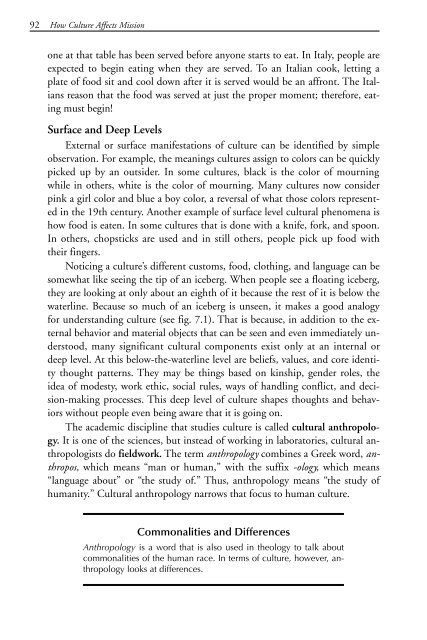discovering missions - Southern Nazarene University
discovering missions - Southern Nazarene University
discovering missions - Southern Nazarene University
Create successful ePaper yourself
Turn your PDF publications into a flip-book with our unique Google optimized e-Paper software.
245187 Disc Missions ins 9/6/07 1:04 PM Page 92<br />
92 How Culture Affects Mission<br />
one at that table has been served before anyone starts to eat. In Italy, people are<br />
expected to begin eating when they are served. To an Italian cook, letting a<br />
plate of food sit and cool down after it is served would be an affront. The Italians<br />
reason that the food was served at just the proper moment; therefore, eating<br />
must begin!<br />
Surface and Deep Levels<br />
External or surface manifestations of culture can be identified by simple<br />
observation. For example, the meanings cultures assign to colors can be quickly<br />
picked up by an outsider. In some cultures, black is the color of mourning<br />
while in others, white is the color of mourning. Many cultures now consider<br />
pink a girl color and blue a boy color, a reversal of what those colors represented<br />
in the 19th century. Another example of surface level cultural phenomena is<br />
how food is eaten. In some cultures that is done with a knife, fork, and spoon.<br />
In others, chopsticks are used and in still others, people pick up food with<br />
their fingers.<br />
Noticing a culture’s different customs, food, clothing, and language can be<br />
somewhat like seeing the tip of an iceberg. When people see a floating iceberg,<br />
they are looking at only about an eighth of it because the rest of it is below the<br />
waterline. Because so much of an iceberg is unseen, it makes a good analogy<br />
for understanding culture (see fig. 7.1). That is because, in addition to the external<br />
behavior and material objects that can be seen and even immediately understood,<br />
many significant cultural components exist only at an internal or<br />
deep level. At this below-the-waterline level are beliefs, values, and core identity<br />
thought patterns. They may be things based on kinship, gender roles, the<br />
idea of modesty, work ethic, social rules, ways of handling conflict, and decision-making<br />
processes. This deep level of culture shapes thoughts and behaviors<br />
without people even being aware that it is going on.<br />
The academic discipline that studies culture is called cultural anthropology.<br />
It is one of the sciences, but instead of working in laboratories, cultural anthropologists<br />
do fieldwork. The term anthropology combines a Greek word, anthropos,<br />
which means “man or human,” with the suffix -ology, which means<br />
“language about” or “the study of.” Thus, anthropology means “the study of<br />
humanity.” Cultural anthropology narrows that focus to human culture.<br />
Commonalities and Differences<br />
Anthropology is a word that is also used in theology to talk about<br />
commonalities of the human race. In terms of culture, however, anthropology<br />
looks at differences.

















